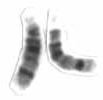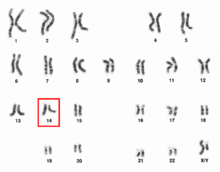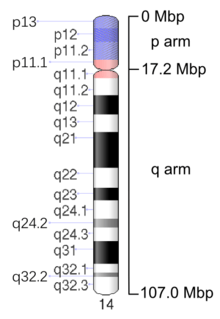Chromosome 14 (human)
| Chromosome 14 (human) | |
|---|---|
 Pair of human chromosome 14 (after G-banding). One is from mother, one is from father. | |
 Chromosome 14 pair in human male karyogram. | |
| Features | |
| Length (bp) | 107,043,718 bp |
| Number of genes | 1,655 |
| Type | Autosome |
| Centromere position | Acrocentric[1] |
| Identifiers | |
| RefSeq | NC_000014 |
| GenBank | CM000676 |

Ideogram of human chromosome 14. Mbp means mega base pair. See locus for other notation.
Chromosome 14 is one of the 23 pairs of chromosomes in humans. People normally have two copies of this chromosome. Chromosome 14 spans about 107 million base pairs (the building material of DNA) and represents between 3 and 3.5% of the total DNA in cells.
Identifying genes on each chromosome is an active area of genetic research. Because researchers use different approaches to predict the number of genes on each chromosome, the estimated number of genes varies. Chromosome 14 likely contains between 700 and 1,300 genes.
The centromere of chromosome 14 is positioned approximately at position 19.0-19.1 Mbp.
Genes
The following are some of the genes located on chromosome 14:
- ACIN1: encoding protein Apoptotic chromatin condensation inducer in the nucleus
- ATXN3: Ataxin-3 (Machado-Joseph disease)
- C14orf32/MAPK1IP1L: encoding protein MAPK-interacting and spindle-stabilizing protein-like
- C14orf79: encoding protein Uncharacterized protein C14orf79
- C14orf93: encoding protein C14orf93
- C14orf133: encoding protein Uncharacterized protein C14orf133
- C14orf159: encoding protein UPF0317 protein C14orf159, mitochondrial
- C14orf166: encoding protein UPF0568 protein C14orf166
- C14orf169: encoding protein Chromosome 14 open reading frame 169
- COCH: coagulation factor C homolog, cochlin (Limulus polyphemus)
- DDX24: encoding enzyme ATP-dependent RNA helicase DDX24
- GALC: galactosylceramidase (Krabbe disease)
- GCH1: GTP cyclohydrolase 1 (dopa-responsive dystonia)
- IGH@: immunoglobulin heavy chain locus
- IFT43: intraflagellar transport 43
- MYH7: myosin heavy chain beta (MHC-β) isoform[2]
- NPC2: Niemann-Pick disease, type C2
- PSEN1: presenilin 1 (Alzheimer disease 3)
- RPL10L: encoding protein 60S ribosomal protein L10-like
- SERPINA1: serpin peptidase inhibitor, clade A (alpha-1 antiproteinase, antitrypsin), member 1
- TSHR: thyroid stimulating hormone receptor
- FAM71D: Family With Sequence Similarity 71, Member D
Diseases and disorders
The following diseases are some of those related to genes on chromosome 14:
- alpha-1 antitrypsin deficiency
- Alzheimer disease
- Burkitt's lymphoma (t8;14)
- congenital hypothyroidism
- dopamine-responsive dystonia
- Follicular lymphoma (t14;18)
- Hypertrophic cardiomyopathy
- Krabbe disease
- Cranio–lenticulo–sutural dysplasia
- Machado-Joseph disease
- Mosaic monosomy 14
- Multiple myeloma
- Niemann-Pick disease
- Nonsyndromic deafness
- Sensenbrenner syndrome
- Tetrahydrobiopterin deficiency
- Uniparental disomy (UPD) 14
References
- ↑ "Table 2.3: Human chromosome groups". Human Molecular Genetics (2nd ed.). Garland Science. 1999.
- ↑ Quiat D, Voelker KA, Pei J, Grishin NV, Grange RW, Bassel-Duby R, Olson EN (June 2011). "Concerted regulation of myofiber-specific gene expression and muscle performance by the transcriptional repressor Sox6". Proc. Natl. Acad. Sci. U.S.A. 108 (25): 10196–201. doi:10.1073/pnas.1107413108. PMC 3121857
 . PMID 21633012.
. PMID 21633012.
- Campo E (2003). "Genetic and molecular genetic studies in the diagnosis of B-cell lymphomas I: mantle cell lymphoma, follicular lymphoma, and Burkitt's lymphoma". Hum Pathol. 34 (4): 330–5. doi:10.1053/hupa.2003.97. PMID 12733111.
- Gilbert F (1999). "Disease genes and chromosomes: disease maps of the human genome. Chromosome 14". Genet Test. 3 (4): 379–91. PMID 10627948.
- Heilig R, Eckenberg R, Petit JL, Fonknechten N, Da Silva C, Cattolico L, Levy M, Barbe V, de Berardinis V, Ureta-Vidal A, Pelletier E, Vico V, Anthouard V, Rowen L, Madan A, Qin S, Sun H, Du H, Pepin K, Artiguenave F, Robert C, Cruaud C, Bruls T, Jaillon O, Friedlander L, Samson G, Brottier P, Cure S, Segurens B, Aniere F, Samain S, Crespeau H, Abbasi N, Aiach N, Boscus D, Dickhoff R, Dors M, Dubois I, Friedman C, Gouyvenoux M, James R, Madan A, Mairey-Estrada B, Mangenot S, Martins N, Menard M, Oztas S, Ratcliffe A, Shaffer T, Trask B, Vacherie B, Bellemere C, Belser C, Besnard-Gonnet M, Bartol-Mavel D, Boutard M, Briez-Silla S, Combette S, Dufosse-Laurent V, Ferron C, Lechaplais C, Louesse C, Muselet D, Magdelenat G, Pateau E, Petit E, Sirvain-Trukniewicz P, Trybou A, Vega-Czarny N, Bataille E, Bluet E, Bordelais I, Dubois M, Dumont C, Guerin T, Haffray S, Hammadi R, Muanga J, Pellouin V, Robert D, Wunderle E, Gauguet G, Roy A, Sainte-Marthe L, Verdier J, Verdier-Discala C, Hillier L, Fulton L, McPherson J, Matsuda F, Wilson R, Scarpelli C, Gyapay G, Wincker P, Saurin W, Quetier F, Waterston R, Hood L, Weissenbach J (2003). "The DNA sequence and analysis of human chromosome 14". Nature. 421 (6923): 601–7. doi:10.1038/nature01348. PMID 12508121.
- Kamnasaran D, Cox DW (2002). "Current status of human chromosome 14". J Med Genet. 39 (2): 81–90. doi:10.1136/jmg.39.2.81. PMC 1735028
 . PMID 11836355.
. PMID 11836355. - Lemire EG, Cardwell S (1999). "Unusual phenotype in partial trisomy 14". Am J Med Genet. 87 (4): 294–6. doi:10.1002/(SICI)1096-8628(19991203)87:4<294::AID-AJMG2>3.0.CO;2-S. PMID 10588832.
- van Karnebeek CD, Quik S, Sluijter S, Hulsbeek MM, Hoovers JM, Hennekam RC (2002). "Further delineation of the chromosome 14q terminal deletion syndrome". Am J Med Genet. 110 (1): 65–72. doi:10.1002/ajmg.10207. PMID 12116274.
| Wikimedia Commons has media related to Human chromosome 14. |
This article is issued from Wikipedia - version of the 10/20/2016. The text is available under the Creative Commons Attribution/Share Alike but additional terms may apply for the media files.